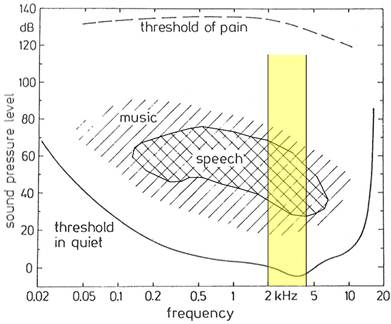Psychoacoustics of chalkboard squeaking
Christoph Reuter – christoph.reuter@univie.ac.at
University of Vienna, Musicological Institute
Spitalgasse 2-4, Campus Hof 9
1090 Vienna, Austria
Michael Oehler – michael.oehler@mhmk.de
MHMK – University of Applied Sciences for Media and Communication
Richmodstrasse 10
50667 Cologne, Germany
Popular version of paper 4pPP6 presented at the 2011 162nd ASA Meeting in San Diego, CA.
There are many different sounds that people perceive as unpleasant or that may cause physiological reactions, like chills down the spine. These sounds include scraping a plate with a fork, squeaking Styrofoam or scratching fingernails on a chalkboard. Sometimes simply imagining these sounds or actions may cause the corresponding perception or physiological reaction (Halpern et al., 1986).
The aim of our study was to detect specific features of the sounds responsible for the perceived unpleasantness. We wanted to know if (a) there was a correlation between perception and physiological reaction and (b) if knowledge about the origin of the sounds influences subjects’ ratings and physiological reactions of these sounds.
First, a listening test determined the two most unpleasant sounds out of several potentially unpleasant sounds: scratching fingernails on a chalkboard (sound example 1) and squeaking chalk on a slate (sound example 2). Then, variations of both sounds were produced by attenuating different frequency ranges or extracting tonal components (harmonic parts) and scraping components (noise parts). Subjects were asked to rate the pleasantness or unpleasantness of the sounds while physiological parameters, like heart rate, blood pressure and galvanic skin response, were measured. One-half of the subjects knew the origin of the sounds. The other half was told that they would hear sounds taken from pieces of contemporary music.
The most significant result was that the parts of the sounds in the frequency range between 2000 Hz and 4000 Hz were particularly important for the perceived unpleasantness. Attenuating the frequencies in this range leads to a much more pleasant impression of the sounds. This is remarkable because between about 2000 Hz and 4000 Hz, the human ear is most sensitive, and many important acoustic features of speech sounds can be found in this frequency band (see Figure 1). One explanation for this sensitivity is the “open ear gain”, i.e., some frequencies are amplified due to the anatomy of the earcanal. Another observed effect was the influence of pitch. Sounds with deleted pitch information were rated as significantly more pleasant, whereas deleted noise parts did not influence the ratings.

Figure 1. Hearing area between threshold in quiet an threshold of pain. Also indicated are the areas encompassed by music and speech and the area between 2000 Hz and 4000 Hz, where the human ear is most sensitive. The parts of the sounds in this frequency range were particularly important for the perceived unpleasantness (after Fastl & Zwicker, 2006, p. 17).
The physiological measurements showed that the galvanic skin response, in particular, is related to subjects’ judgments (the skin conductance varies with the moisture level of the skin). Sounds that were rated as more unpleasant produced a greater difference in the subjects’ galvanic skin response before and during the sound presentation. If the subjects knew the origin of the sounds, the judgments tended to be more negative, and the correlation between perception and galvanic skin response was even stronger. Conversely, if the subjects thought they were hearing parts of a contemporary composition, they perceived the sounds as less unpleasant.
Based on these findings, it can be said that the relevant acoustic characteristics of unpleasant sounds can be found in the pitch information and in the frequency range between 2000 Hz and 4000 Hz, where the ear is most sensitive. Such (unpleasant) sounds seem to evoke a physical reaction in the listener—in other words, the galvanic skin response changes significantly, and in addition, knowledge about the origins of the sounds (e.g., scratching fingernails on a chalkboard) leads to more negative ratings and stronger physiological effects.
References
Fastl, H. & Zwicker, E. (2006). Psychoacoustics. Facts and models. Berlin: Springer.
Halpern, D.L., Blake, R. & Hillenbrand, J. (1986). Psychoacoustics of a chilling sound. Perception & Psychophysics, 39 (2), 77-80.
